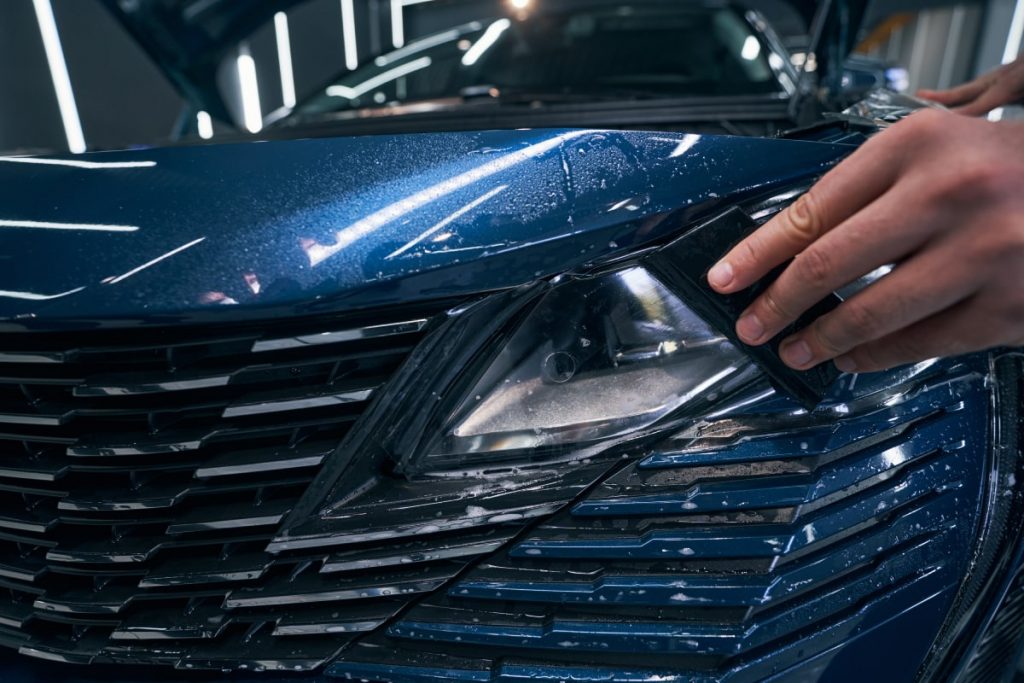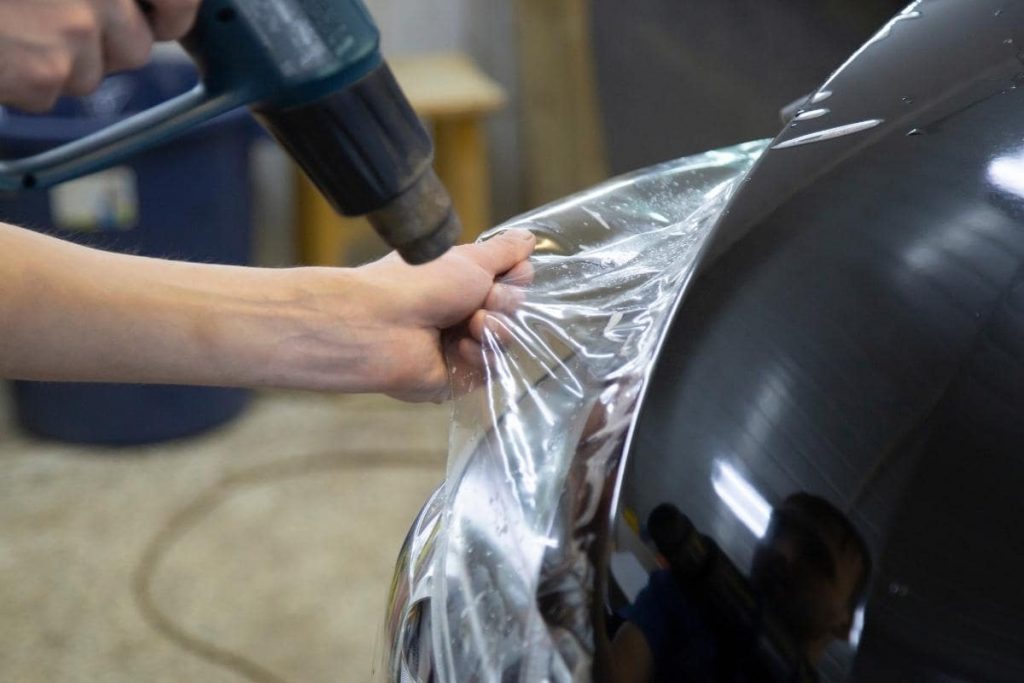
Deciding between Paint Protection Film (PPF) and ceramic coating to protect your vehicle isn’t always easy for Ottawa drivers.
If you care about keeping your car in good condition, protecting it from the harsh elements is always a consideration. Whether it’s bug splatters, UV rays, chemical etching, or road debris, there are plenty of reasons to want to keep your car tucked away in the garage.
Luckily, there are options to protect your car and maintain its pristine condition. Car owners have plenty of options, and one of the most popular choices is between automotive paint protection film vs ceramic coating.
So how do you know which one is better for you? Let’s dive in and take a look at some of the differences between the two options for keeping your vehicle’s paint pristine.
Table of Contents
What is Paint Protection Film?

Paint protection film (PPF) is a transparent thermoplastic urethane film that can go over any painted surface of your vehicle’s exterior. It preserves the quality of the paint by reducing the risk of multiple kinds of damage to your car paint, such as light scratches from a rock chip, chemical stains from acidic contaminants, hard water spots from mineral deposits, and swirl marks from washing.
Paint protection film is completely safe to apply to your new car, and can be easily removed. They also have many trusted brands like Xpel Paint Protection.
What is Ceramic Coating?

Ceramic coatings are a permanent or semi-permanent solution that protects car paint from external damage. A ceramic coating is a liquid polymer that chemically bonds with your car’s paint surface, which acts as a layer of protection and a hydrophobic surface.
Water and other debris will have a harder time sticking to your car’s exterior. Ceramic coatings will allow your car to stay cleaner for longer, and make it easier to clean when you do need to head to the car wash.
Pros & Cons of Paint Protection Film

Pros
The biggest draw towards paint protection film is its resistance towards scratches and scuffs, or its “self-healing” properties. This means that paint protection film is able to absorb minor scratches from rock chips or road debris and essentially make them disappear. A good quality paint protection film will be made of elastomeric polymers that can return to their natural shape after being stretched. When rock chips, branches, or other debris, inflict damage on the paint protection film, it absorbs it and returns to its original state.
Paint protection film is thicker than ceramic coatings, and its self-healing properties are the main draw. It provides long-term, invisible protection, and will keep your brand new car looking nice for much longer.
Cons
Paint protection film is removable, but you can’t reapply that same film again after it’s been taken off. And while paint protection films have hydrophobic properties, it’s not to the same degree as ceramic coatings.
Early complaints against paint protection film is that after a while, it began to turn yellow, or “blister” with air bubbles, or peel away from the paint underneath. Yellowing is caused by inferior adhesives that aren’t UV resistant, and blistering or car paint peeling is caused by improper application. All of these liabilities are preventable with proper installation of a quality, reputable product.
Not all paint protection products are equal, and the automotive industry has plenty of options to consider. It’s important to choose the right type before adding a protective layer to your entire car. Do some research, and don’t be afraid to set up a consultation with a certified installer to help guide you in the right direction.
Learn whether Paint Protection film is worth your investment.
Pros & Cons of Ceramic Coating
Pros
Ceramic coating makes your vehicle look amazing, with a deep candy-like gloss. Because it’s bonded with the paint itself, there’s no need to reapply a ceramic coating, like you would with car wax or powder coating.
The nano-coating provides an excellent hydrophobic clear coat, which repels water and allows any mud or grime to bead on the surface and slide off. With a ceramic coating applied, a quick wash with a hose will give you a spotless, shiny surface.
The liquid polymer coating also helps protect the whole vehicle from excessive UV exposure, as well as reducing excessive heat in your car’s interior. If you park your car outside, a ceramic coating is great for preventing your entire vehicle from oxidizing and fading in the sun.
Cons
Applying ceramic coating isn’t right for every driver. If you’re concerned about the potential for scratches, flying debris, and keeping your vehicle free of even tiny imperfections, you’d be better off with a paint protection film. A ceramic coating can repel water, but it doesn’t remove it, and spots or swirl marks are still a possibility.
The process of giving a whole car a ceramic coating is also fairly time-consuming and difficult. Along with the materials and growing demand, ceramic coatings can get quite expensive.
How Long Does Paint Protection Film and Ceramic Coating Last?

The amount of time these two options last differs quite a bit.
High-quality PPF that is properly applied can last five to ten years. It really depends on the driving conditions you expose it to. PPF has “self-healing” properties and resists yellowing from sun exposure.
Ceramic coatings have a much shorter lifespan and will last between two and five years. Ceramic coating’s chemical resistance and sun protection keep the paint glossy and new-looking.
Regular maintenance can extend the lifespan of both. You can maintain your vehicle’s PPF with regular washing while avoiding harsh chemicals that degrade the film. Ceramic coatings, while more durable against chemicals, still require careful washing to maintain their hydrophobic properties.
Both solutions provide protection. Which one you choose will depend on the driving conditions you regularly put your vehicle through.
How Well Does Paint Protection Film and Ceramic Coating Protect My Car?
PPF will do a great job protecting the parts of your vehicle you put it on from physical damage. Its thick, flexible nature absorbs impacts from small rocks, debris, and minor scratches, making it ideal for areas prone to this kind of damage. PPF has “self-healing” properties: it’s able to absorb minor scratches and make them “disappear”. It also prevents paint fading with protection against the sun.
A ceramic coating, while not as effective against rocks and scratches from other cars, does protect your car’s paint from environmental contaminants. Ceramic coatings create a chemical-resistant barrier that shields paint from bird droppings, tree sap, and acid rain. Additionally, the hydrophobic nature of ceramic coatings makes it easier to clean the outside of your vehicle and reduces water spots and the amount of dirt and dust that naturally accumulates.
Both PPF and ceramic coatings help protect your vehicle’s paint. If you’re concerned about scratches and rock chips, PPF is the way to go. If you prefer a low-maintenance solution that guards against chemical damage and keeps your car looking shiny and clean, ceramic coating might be the better choice.
How Much Does Paint Protection Film and Ceramic Coating Cost?
The cost of both PPF and ceramic coatings depends on your vehicle size, the quality of the product you choose, and how much of your vehicle you choose to protect.
PPF can cost from $1000 to $6,000 or more, depending on how much of your vehicle you choose to cover. Professional installation does cost more but is worth it. PPF gives your vehicle a high amount of protection against physical damage, which justifies the higher cost for some, especially if you have a new car or a high-end or restored vintage one. If you commute along highways or gravel roads where you’re likely to have rocks kicking up against your front end, protecting some areas like the front bumper, hood, fenders, and headlights with PPF is a good idea.
If you do go with PPF, make sure you choose a professional installer who won’t leave visible seams. You’ll know they’ve done a great job if you can’t even tell the vehicle has been wrapped in PFF at all.
Ceramic coatings, while less expensive, will still cost between $500 and $2,000, depending on the quality of the product you choose and the complexity of the application. Ceramic coatings provide a balance between cost and protection, particularly for those more concerned with environmental damage and ease of cleaning.
Both options can save you money on paint repairs down the road. Giving some thought to your budget, the vehicle you drive, and where you drive on a daily basis will help you choose the best option.
Can I Apply Both Paint Protection Film and Ceramic Coating to My Vehicle?

Yes, applying both PPF and ceramic coating to your vehicle will provide even more protection than either one on its own.
PPF can be applied to high-impact areas to guard against physical damage, while ceramic coating can be applied over the entire vehicle, including over the PPF. This combination gives your vehicle the impact protection of PPF and the chemical, environmental, and sun protection of ceramic coating (along with the easy cleaning benefits).
Adding both is an investment, but the extended protection can be worth the investment. Your vehicle will not only look great but also keep its value over time.
Which is Best: Paint Protection Film vs Ceramic Coating?
So, which option is right for your car? There’s plenty of factors to consider when you’re choosing between paint protection film and ceramic coatings. Considering how different these two options are, the similarities between them are fairly extensive. Both work to invisibly protect and keep your car cleaner, especially against oxidation from UV rays, chemical stains from acid rain and bird droppings, and chemical etch marks caused by acidic contaminants.
Ceramic coatings do offer hydrophobic properties and a shiny, glossy finish, but can’t protect your car’s paint against physical damage. It’s also not as good at preventing swirl marks and water spots. However, if your goal is to improve the appearance of your car and keep it clean for longer, ceramic coatings are a great choice.
However, if your goals is to protect your car and keep it looking nice for as long as possible, paint protection film is the clear choice. It protects car paint while taking on the scratches, dirt, and damages that are inevitable when driving.
Paint protection films also protect your car’s exterior from harmful and damaging UV rays. Not only does it offer durable protection, but it also provides a hydrophobic surface to repel water and mud.
Paint protection films provide flexibility too, so if you don’t want to commit to wrapping your full vehicle, you can choose to apply it in a clear bra to the front bumper, or even a partial hood wrap. They have many of the best protection film brands like XPEL and 3M.
Protect Your Car’s Paint Job With Bemac
If you’re interested in protecting your car, bring it to Bemac Collision and Service. We’re automotive paint protection film experts, with shops all over the Ottawa/Gatineau area. Our experienced staff is here to help you with everything you need to know about protecting your vehicle.
Contact us to get a free quote today!
1 “Paint Protection Film.” Wikipedia, 17 June 2024, https://en.wikipedia.org/wiki/Paint_protection_film. Accessed 17 June 2024.
2 “Wikipedia: Ceramic Coating.” WikiAlpha, 17 June 2024, https://en.wikialpha.org/wiki/Ceramic_coating. Accessed 17 June 2024.








